博迪投资学Chap021PPT课件
- 格式:pptx
- 大小:1.39 MB
- 文档页数:40
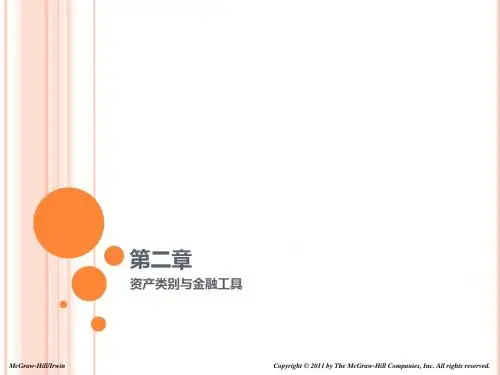
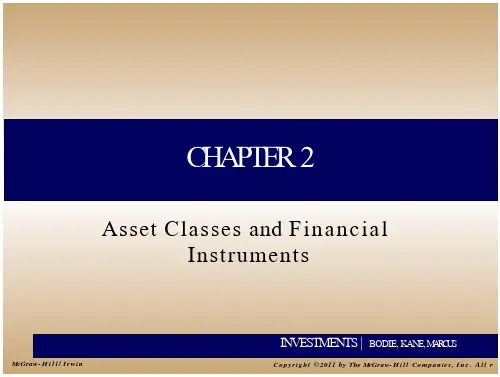
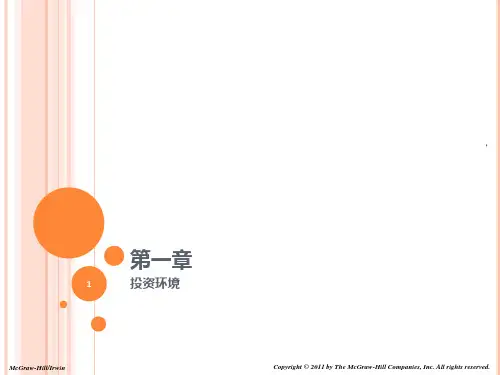
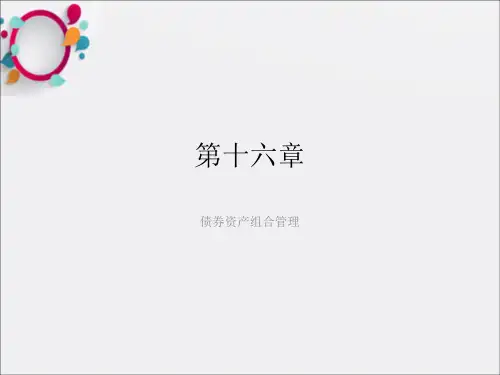
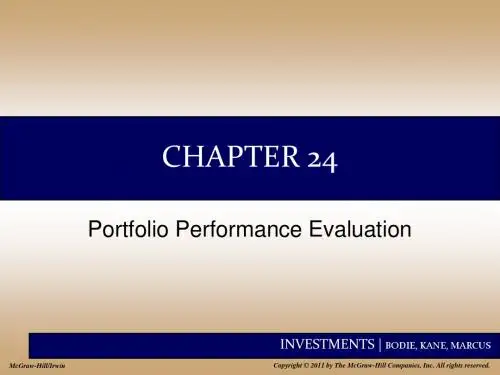
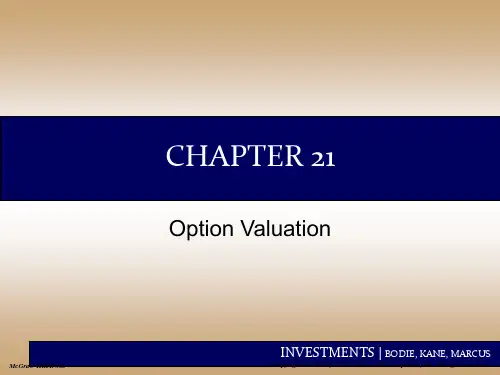
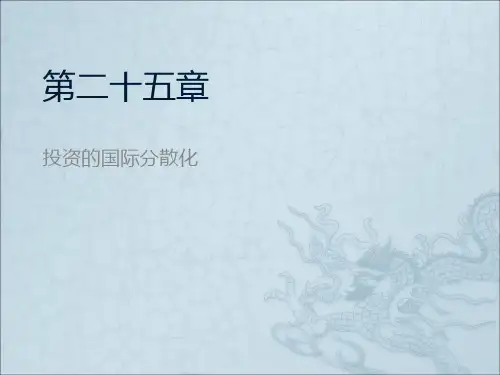
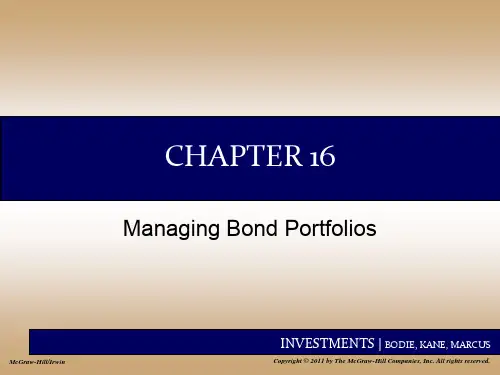
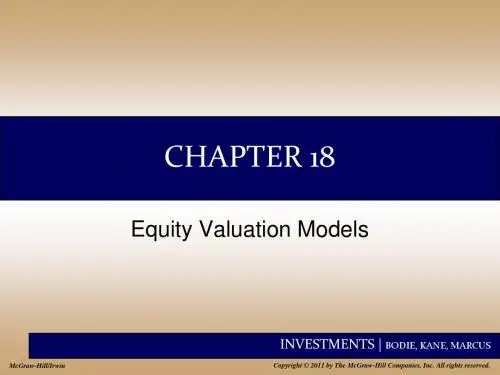
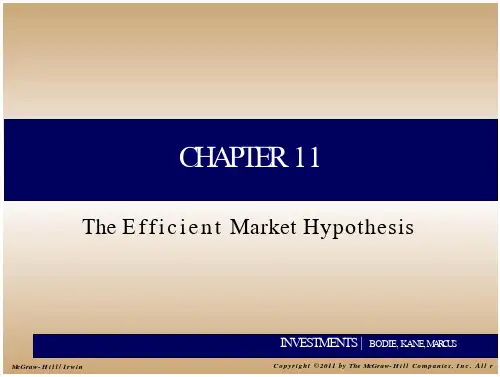
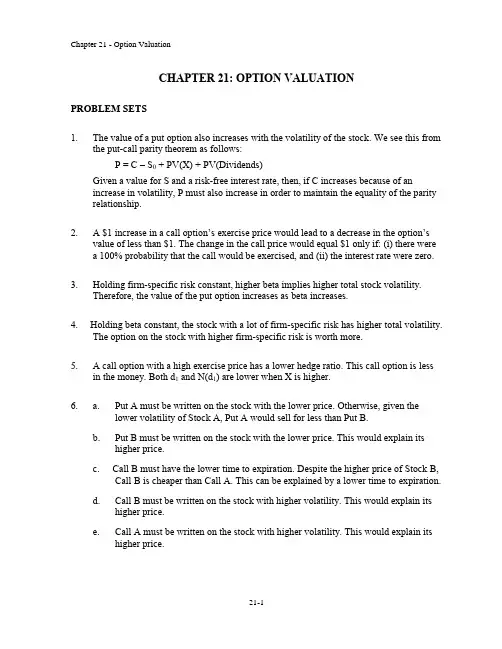
CHAPTER 21: OPTION VALUATIONPROBLEM SETS1. The value of a put option also increases with the volatility of the stock. We see this from theput-call parity theorem as follows:P = C – S0 + PV(X) + PV(Dividends)Given a value for S and a risk-free interest rate, then, if C increases because of an increase in volatility, P must also increase in order to maintain the equality of the parity relationship.2. A $1 increase in a call option’s exercise price would lead to a decrease in the option’s value ofless than $1. The change in the call price would equal $1 only if: (i) there were a 100%probability that the call would be exercised, and (ii) the interest rate were zero.3. Holding firm-specific risk constant, higher beta implies higher total stock volatility. Therefore,the value of the put option increases as beta increases.4. Holding beta constant, the stock with a lot of firm-specific risk has higher total volatility. Theoption on the stock with higher firm-specific risk is worth more.5. A call option with a high exercise price has a lower hedge ratio. This call option is less in themoney. Both d1 and N(d1) are lower when X is higher.6. a. Put A must be written on the stock with the lower price. Otherwise, given the lowervolatility of Stock A, Put A would sell for less than Put B.b. Put B must be written on the stock with the lower price. This would explain its higherprice.c. Call B must have the lower time to expiration. Despite the higher price of Stock B, CallB is cheaper than Call A. This can be explained by a lower time to expiration.d. Call B must be written on the stock with higher volatility. This would explain its higherprice.e. Call A must be written on the stock with higher volatility. This would explain its higherprice.7.Exercise Price Hedge Ratio 120 0/30 = 0.000 110 10/30 = 0.333 100 20/30 = 0.667 90 30/30 = 1.000As the option becomes more in the money, the hedge ratio increases to a maximum of 1.0.8.S d 1 N(d 1) 45 -0.0268 0.4893 50 0.5000 0.6915 550.97660.83569.a. uS 0 = 130 ⇒ P u = 0 dS 0 = 80 ⇒ P d = 30 The hedge ratio is:5380130300dS uS P P H 00d u -=--=--=b.Riskless Portfolio S = 80 S = 130 Buy 3 shares 240 390 Buy 5 puts 150 0 Total390390Present value = $390/1.10 = $354.545c.The portfolio cost is: 3S + 5P = 300 + 5P The value of the portfolio is: $354.545 Therefore: P = $54.545/5 = $10.9110. The hedge ratio for the call is:5280130020dS uS C C H 00d u =--=--=Riskless Portfolio S = 80 S = 130 Buy 2 shares 160 260 Write 5 calls 0 -100 Total160160Present value = $160/1.10 = $145.455 The portfolio cost is: 2S – 5C = $200 – 5C The value of the portfolio is: $145.455 Therefore: C = $54.545/5 = $10.91 Does P = C + PV(X) – S?10.91 = 10.91 + 110/1.10 – 100 = 10.9111. d 1 = 0.3182 ⇒ N(d 1) = 0.6248d 2 = –0.0354 ⇒ N(d 2) = 0.4859 Xe - r T = 47.56 C = $8.1312. P = $5.69This value is derived from our Black-Scholes spreadsheet, but note that we could have derived the value from put-call parity:P = C + PV(X) – S 0 = $8.13 + $47.56 - $50 = $5.6913. a. C falls to $5.5541b. C falls to $4.7911c. C falls to $6.0778d. C rises to $11.5066e. C rises to $8.718714. According to the Black-Scholes model, the call option should be priced at:[$55 ⨯ N(d1)] – [50 ⨯ N(d 2)] = ($55 ⨯ 0.6) – ($50 ⨯ 0.5) = $8Since the option actually sells for more than $8, implied volatility is greater than 0.30.15. A straddle is a call and a put. The Black-Scholes value would be:C + P = S0 N(d1) - Xe–rT N(d 2) + Xe–rT [1 - N(d 2)] - S0 [1 - N(d1)]= S0 [2N(d1) - 1] + Xe–rT [1 - 2N(d 2)]On the Excel spreadsheet (Spreadsheet 21.1), the valuation formula would be:B5*(2*E4 - 1) + B6*EXP(-B4*B3)*(1 - 2*E5)16. The rate of return of a call option on a long-term Treasury bond should be more sensitive tochanges in interest rates than is the rate of return of the underlying bond. The option elasticityexceeds 1.0. In other words, the option is effectively a levered investment and the rate of return on the option is more sensitive to interest rate swings.17. Implied volatility has increased. If not, the call price would have fallen as a result of thedecrease in stock price.18. Implied volatility has increased. If not, the put price would have fallen as a result of thedecreased time to expiration.19. The hedge ratio approaches one. As S increases, the probability of exercise approaches 1.0.N(d1) approaches 1.0.20. The hedge ratio approaches –1.0. As S decreases, the probability of exercise approaches 1.[N(d1) –1] approaches –1 as N(d1) approaches 0.21. A straddle is a call and a put. The hedge ratio of the straddle is the sum of the hedge ratios ofthe individual options: 0.4 + (–0.6) = –0.222. a. The spreadsheet appears as follows:The standard deviation is: 0.3213b. The spreadsheet below shows the standard deviation has increased to: 0.3568Implied volatility has increased because the value of an option increases with greatervolatility.c. Implied volatility increases to 0.4087 when expiration decreases to four months. Theshorter expiration decreases the value of the option; therefore, in order for the optionprice to remain unchanged at $8, implied volatility must increase.d. Implied volatility decreases to 0.2406 when exercise price decreases to $100. Thedecrease in exercise price increases the value of the call, so that, in order to the optionprice to remain at $8, implied volatility decreases.e. The decrease in stock price decreases the value of the call. In order for the option priceto remain at $8, implied volatility increases.23. a. The delta of the collar is calculated as follows:Position DeltaBuy stock 1.0Buy put, X = $45 N(d1) – 1 = –0.40Write call, X = $55 –N(d1) = –0.35Total 0.25If the stock price increases by $1, then the value of the collar increases by $0.25. Thestock will be worth $1 more, the loss on the purchased put will be $0.40, and the callwritten represents a liability that increases by $0.35.b.If S becomes very large, then the delta of the collar approaches zero. Both N(d1) termsapproach 1. Intuitively, for very large stock prices, the value of the portfolio is simply the(present value of the) exercise price of the call, and is unaffected by small changes in thestock price.As S approaches zero, the delta also approaches zero: both N(d1) terms approach 0.For very small stock prices, the value of the portfolio is simply the (present value of the)exercise price of the put, and is unaffected by small changes in the stock price.24. Put X DeltaA 10 -0.1B 20 -0.5C 30 -0.925. a. Choice A: Calls have higher elasticity than shares. For equal dollar investments, a call’scapital gain potential is greater than that of the underlying stock.b. Choice B: Calls have hedge ratios less than 1.0, so the shares have higher profit potential.For an equal number of shares controlled, the dollar exposure of the shares is greaterthan that of the calls, and the profit potential is therefore greater.26. a. uS 0 = 110 ⇒ P u = 0 dS 0 = 90 ⇒ P d = 10 The hedge ratio is:2190110100dS uS P P H 00d u -=--=--=A portfolio comprised of one share and two puts provides a guaranteed payoff of $110, with present value: $110/1.05 = $104.76 Therefore:S + 2P = $104.76$100 + 2P = $104.76 ⇒ P = $2.38b. Cost of protective put portfolio = $100 + $2.38 = $102.38c.Our goal is a portfolio with the same exposure to the stock as the hypothetical protective put portfolio. Since the put’s hedge ratio is –0.5, the portfolio consists of (1 – 0.5) = 0.5 shares of stock, which costs $50, and the remaining funds ($52.38) invested in T-bills, earning 5% interest. Portfolio S = 90 S = 110 Buy 0.5 shares 45 55 Invest in T-bills 55 55 Total100110This payoff is identical to that of the protective put portfolio. Thus, the stock plus bills strategy replicates both the cost and payoff of the protective put.27. The put values in the second period are:P uu = 0P ud = P du = 110 − 104.50 = 5.50 P dd = 110 − 90.25 = 19.75To compute P u , first compute the hedge ratio:3150.10412150.50udSuuSP P H 0ud uu -=--=--=Form a riskless portfolio by buying one share of stock and buying three puts. The cost of the portfolio is: S + 3P u = $110 + 3P u The payoff for the riskless portfolio equals $121: Riskless Portfolio S = 104.50 S = 121 Buy 1 share 104.50 121.00 Buy 3 puts 16.50 0.00 Total121.00121.00Therefore, find the value of the put by solving:$110 + 3P u = $121/1.05 ⇒ P u = $1.746 To compute P d , compute the hedge ratio:0.125.9050.10475.1950.5ddSduSP P H 0dd du -=--=--=Form a riskless portfolio by buying one share and buying one put. The cost of the portfolio is: S + P d = $95 + P d The payoff for the riskless portfolio equals $110: Riskless Portfolio S = 90.25 S = 104.50 Buy 1 share 90.25 104.50 Buy 1 put 19.75 5.50 Total110.00110.00Therefore, find the value of the put by solving:$95 + P d = $110/1.05 ⇒ P d = $9.762 To compute P, compute the hedge ratio:5344.095110762.9746.1dS uS P P H 00d u -=--=--=Form a riskless portfolio by buying 0.5344 of a share and buying one put. The cost of the portfolio is: 0.5344S + P = $53.44 + PThe payoff for the riskless portfolio equals $60.53:Riskless Portfolio S = 95 S = 110Buy 0.5344 share 50.768 58.784Buy 1 put 9.762 1.746Total 60.530 60.530Therefore, find the value of the put by solving:$53.44 + P = $60.53/1.05 ⇒ P = $4.208Finally, we verify this result using put-call parity. Recall from Example 21.1 that:C = $4.434Put-call parity requires that:P = C + PV(X) – S$4.208 = $4.434 + ($110/1.052) - $100Except for minor rounding error, put-call parity is satisfied.28. If r = 0, then one should never exercise a put early. There is no “time value cost” to waiting toexercise, but there is a “volatility benefit” from waiting. To show this more rigorously, consider the following portfolio: lend $X and short one share of stock. The cost to establish the portfolio is (X – S 0). The payoff at time T (with zero interest earnings on the loan) is (X – S T). Incontrast, a put option has a payoff at time T of (X – S T) if that value is positive, and zerootherwise. The put’s payoff is at least as large as the portfolio’s, and therefore, the put must cost at least as much as the portfolio to purchase. Hence, P ≥ (X – S 0), and the put can be sold for more than the proceeds from immediate exercise. We conclude that it doesn’t pay to exercise early.29. a. Xe-rTb. Xc. 0d. 0e. It is optimal to exercise immediately a put on a stock whose price has fallen to zero. Thevalue of the American put equals the exercise price. Any delay in exercise lowers valueby the time value of money.30. Step 1: Calculate the option values at expiration. The two possible stock prices and thecorresponding call values are:uS 0 = 120 ⇒ C u = 20 dS 0 = 80 ⇒ C d = 0 Step 2: Calculate the hedge ratio.2180120020dS uS C C H 00d u =--=--=Therefore, form a riskless portfolio by buying one share of stock and writing two calls. The cost of the portfolio is: S – 2C = 100 – 2CStep 3: Show that the payoff for the riskless portfolio equals $80: Riskless Portfolio S = 80 S = 120 Buy 1 share 80 120 Write 2 calls 0 -40 Total8080Therefore, find the value of the call by solving:$100 – 2C = $80/1.10 ⇒ C = $13.636Notice that we did not use the probabilities of a stock price increase or decrease. These are not needed to value the call option.31.The two possible stock prices and the corresponding call values are:uS 0 = 130 ⇒ C u = 30 dS 0 = 70 ⇒ C d = 0 The hedge ratio is:2170130030dS uS C C H 00d u =--=--=Form a riskless portfolio by buying one share of stock and writing two calls. The cost of the portfolio is: S – 2C = 100 – 2CThe payoff for the riskless portfolio equals $70: Riskless Portfolio S = 70 S = 130 Buy 1 share 70 130 Write 2 calls 0 -60 Total7070Therefore, find the value of the call by solving:$100 – 2C = $70/1.10 ⇒ C = $18.182Here, the value of the call is greater than the value in the lower-volatility scenario.32. The two possible stock prices and the corresponding put values are:uS 0 = 120 ⇒ P u = 0dS 0 = 80 ⇒ P d = 20 The hedge ratio is:2180120200dS uS P P H 00d u -=--=--=Form a riskless portfolio by buying one share of stock and buying two puts. The cost of the portfolio is: S + 2P = 100 + 2PThe payoff for the riskless portfolio equals $120: Riskless Portfolio S = 80 S = 120 Buy 1 share 80 120 Buy 2 puts 40 0 Total120120Therefore, find the value of the put by solving:$100 + 2P = $120/1.10 ⇒ P = $4.545 According to put-call parity: P + S = C + PV(X) Our estimates of option value satisfy this relationship:$4.545 + $100 = $13.636 + $100/1.10 = $104.54533. If we assume that the only possible exercise date is just prior to the ex-dividend date, then therelevant parameters for the Black-Scholes formula are:S 0 = 60r = 0.5% per month X = 55 σ = 7%T = 2 monthsIn this case: C = $6.04If instead, one commits to foregoing early exercise, then we reduce the stock price by the present value of the dividends. Therefore, we use the following parameters:S 0 = 60 – 2e − (0.005 ⨯ 2) = 58.02 r = 0.5% per month X = 55 σ = 7%T = 3 months In this case, C = $5.05The pseudo-American option value is the higher of these two values: $6.0434. True. The call option has an elasticity greater than 1.0. Therefore, the call’s percentage rate ofreturn is greater than that of the underlying stock. Hence the GM call responds more thanproportionately when the GM stock price changes in response to broad market movements.Therefore, the beta of the GM call is greater than the beta of GM stock.35. True. The elasticity of a call option is higher the more out of the money is the option. (Eventhough the delta of the call is lower, the value of the call is also lower. The proportionalresponse of the call price to the stock price increases. You can confirm this with numerical examples.) Therefore, the rate of return of the call with the higher exercise price respondsmore sensitively to changes in the market index, and therefore it has the higher beta.36. As the stock price increases, conversion becomes increasingly more assured. The hedge ratioapproaches 1.0. The price of the convertible bond will move one-for-one with changes in the price of the underlying stock.37. Salomon believes that the market assessment of volatility is too high. Therefore, Salomonshould sell options because the analysis suggests the options are overpriced with respect to true volatility. The delta of the call is 0.6, while that of the put is 0.6 – 1 = –0.4. Therefore, Salomon should sell puts and calls in the ratio of 0.6 to 0.4. For example, if Salomon sells 2 calls and 3 puts, the position will be delta neutral:Delta = (2 ⨯ 0.6) + [3 ⨯ (–0.4)] = 038. If the stock market index increases 1%, the 1 million shares of stock on which the options arewritten would be expected to increase by:0.75% ⨯ $5 ⨯ 1 million = $37,500The options would increase by:delta ⨯ $37,500 = 0.8 ⨯ $37,500 = $30,000In order to hedge your market exposure, you must sell $3,000,000 of the market indexportfolio so that a 1% change in the index would result in a $30,000 change in the value of the portfolio.39. S = 100; current value of portfolioX = 100; floor promised to clients (0% return)σ = 0.25; volatilityr = 0.05; risk-free rateT = 4 years; horizon of programa. Using the Black-Scholes formula, we find that:d1 = 0.65, N(d1) = 0.7422, d 2 = 0.15, N(d 2) = 0.5596Put value = $10.27Therefore, total funds to be managed equals $110.27 million: $100 million portfolio valueplus the $10.27 million fee for the insurance program.The put delta is: N(d1) – 1 = 0.7422 – 1 = –0.2578Therefore, sell off 25.78% of the equity portfolio, placing the remaining funds in T-bills. Theamount of the portfolio in equity is therefore $74.22 million, while the amount in T-bills is:$110.27 million – $74.22 million = $36.05 millionb.At the new portfolio value, the put delta becomes: –0.2779This means that you must reduce the delta of the portfolio by:0.2779 – 0.2578 = 0.0201You should sell an additional 2.01% of the equity position and use the proceeds to buyT-bills. Since the stock price is now at only 97% of its original value, you need to sell: $97 million ⨯ 0.0201 = $1.950 million of stock40. Using the true volatility (32%) and time to expiration T = 0.25 years, the hedge ratio for Exxonis N(d1) = 0.5567. Because you believe the calls are under-priced (selling at an impliedvolatility that is too low), you will buy calls and short 0.5567 shares for each call you buy.41. The calls are cheap (implied σ = 0.30) and the puts are expensive (impliedσ = 0.34). Therefore, buy calls and sell puts. Using the “true” volatility ofσ = 0.32, the call delta is 0.5567 and the put delta is: 0.5567 – 1.0 = –0.4433Therefore, for each call purchased, buy: 0.5567/0.4433 = 1.256 puts42. a.To calculate the hedge ratio, suppose that the market index increases by 1%. Then the stock portfolio would be expected to increase by:1% ⨯ 1.5 = 1.5% or 0.015 ⨯ $1,250,000 = $18,750Given the option delta of 0.8, the option portfolio would increase by:$18,750 ⨯ 0.8 = $15,000Salomon’s liability from writing these options would increase by the same amount. The market index portfolio would increase in value by 1%. Therefore, SalomonBrothers should purchase $1,500,000 of the market index portfolio in order to hedge its position so that a 1% change in the index would result in a $15,000 change in the value of the portfolio.b.The delta of a put option is:0.8 – 1 = –0.2Therefore, for every 1% the market increases, the index will rise by 10 points and the value of the put option contract will change by:delta ⨯ 10 ⨯ contract multiplier = –0.2 ⨯ 10 ⨯ 100 = –$200 Therefore, Salomon should write: $12,000/$200 = 60 put contractsCFA PROBLEMS1. Statement a: The hedge ratio (determining the number of futures contracts to sell) ought to beadjusted by the beta of the equity portfolio, which is 1.20. The correct hedge ratio would be:400,22.1000,2β2,000β500100$million 100$=⨯=⨯=⨯⨯Statement b: The portfolio will be hedged, and should therefore earn the risk-free rate, not zero, as the consultant claims. Given a futures price of 100 and an equity price of 100, the rate of return over the 3-month period is: (100 - 99)/99 = 1.01% = approximately 4.1% annualized 2.a.The value of the call option is expected to decrease if the volatility of the underlying stock price decreases. The less volatile the underlying stock price, the less the chance of extreme price movements and the lower the probability that the option expires in the money. This makes the participation feature on the upside less valuable.The value of the call option is expected to increase if the time to expiration of the option increases. The longer the time to expiration, the greater the chance that the option will expire in the money resulting in an increase in the time premium component of the option’s value.b. i. When European options are out of the money, investors are essentially saying that theyare willing to pay a premium for the right, but not the obligation, to buy or sell theunderlying asset. The out-of-the-money option has no intrinsic value, but, since optionsrequire little capital (just the premium paid) to obtain a relatively large potential payoff,investors are willing to pay that premium even if the option may expire worthless. TheBlack-Scholes model does not reflect investors’ demand for any premium above thetime value of the option. Hence, if investors are willing to pay a premium for an out-of-the-money option above its time value, the Black-Scholes model does not value thatexcess premium.ii. With American options, investors have the right, but not the obligation, to exercise theoption prior to expiration, even if they exercise for non-economic reasons. This increasedflexibility associated with American options has some value but is not considered in theBlack-Scholes model because the model only values options to their expiration date(European options).3. a. American options should cost more (have a higher premium). American options give theinvestor greater flexibility than European options since the investor can choose whetherto exercise early. When the stock pays a dividend, the option to exercise a call early canbe valuable. But regardless of the dividend, a European option (put or call) never sellsfor more than an otherwise-identical American option.b. C = S0 + P - PV(X) = $43 + $4 - $45/1.055 = $4.346Note: we assume that Abaco does not pay any dividends.c. i) An increase in short-term interest rate ⇒ PV(exercise price) is lower, and call valueincreases.ii) An increase in stock price volatility ⇒ the call value increases.iii) A decrease in time to option expiration ⇒ the call value decreases.4. a. The two possible values of the index in the first period are:uS0 = 1.20 × 50 = 60dS0 = 0.80 × 50 = 40The possible values of the index in the second period are:uuS0 = (1.20)2 × 50 = 72udS0 = 1.20 × 0.80 × 50 = 48duS0 = 0.80 × 1.20 × 50 = 48ddS0 = (0.80)2 × 50 = 32C uu = 72 − 60 = 12 C ud = C du = C dd = 0 Since C ud = C du = 0, then C d = 0.To compute C u , first compute the hedge ratio:214872012udSuuSC C H 0ud uu =--=--=Form a riskless portfolio by buying one share of stock and writing two calls. The cost of the portfolio is: S – 2C u = $60 – 2C u The payoff for the riskless portfolio equals $48: Riskless Portfolio S = 48 S = 72 Buy 1 share 48 72 Write 2 calls 0 -24 Total4848Therefore, find the value of the call by solving:$60 – 2C u = $48/1.06 ⇒ C u = $7.358 To compute C, compute the hedge ratio:3679.040600358.7dS uS C C H 00d u =--=--=Form a riskless portfolio by buying 0.3679 of a share and writing one call. The cost of the portfolio is: 0.3679S – C = $18.395 – C The payoff for the riskless portfolio equals $14.716: Riskless Portfolio S = 40 S = 60 Buy 0.3679 share 14.716 22.074 Write 1 call 0.000 −7.358 Total14.71614.716Therefore, find the value of the call by solving:$18.395 – C = $14.716/1.06 ⇒ C = $4.512P uu = 0P ud = P du = 60 − 48 = 12 P dd = 60 − 32 = 28To compute P u , first compute the hedge ratio:214872120udSuuSP P H 0ud uu -=--=--=Form a riskless portfolio by buying one share of stock and buying two puts. The cost of the portfolio is: S + 2P u = $60 + 2P u The payoff for the riskless portfolio equals $72: Riskless Portfolio S = 48 S = 72 Buy 1 share 48 72 Buy 2 puts 24 0 Total7272Therefore, find the value of the put by solving:$60 + 2P u = $72/1.06 ⇒ P u = $3.962 To compute P d , compute the hedge ratio:0.132482812ddSduSP P H 0dd du -=--=--=Form a riskless portfolio by buying one share and buying one put. The cost of the portfolio is: S + P d = $40 + P d The payoff for the riskless portfolio equals $60: Riskless Portfolio S = 32 S = 48 Buy 1 share 32 48 Buy 1 put 28 12 Total6060Therefore, find the value of the put by solving:$40 + P d = $60/1.06 ⇒ P d = $16.604 To compute P, compute the hedge ratio:6321.04060604.16962.3dS uS P P H 00d u -=--=--=Form a riskless portfolio by buying 0.6321 of a share and buying one put.The cost of the portfolio is: 0.6321S + P = $31.605 + PThe payoff for the riskless portfolio equals $41.888:Riskless Portfolio S = 40 S = 60Buy 0.6321 share 25.284 37.926Buy 1 put 16.604 3.962Total 41.888 41.888Therefore, find the value of the put by solving:$31.605 + P = $41.888/1.06 ⇒ P = $7.912d. According to put-call-parity:C = S0 + P - PV(X) = $50 + $7.912 - $60/(1.062 ) = $4.512This is the value of the call calculated in part (b) above.5. a. (i) Index increases to 1402. The combined portfolio will suffer a loss. The written callsexpire in the money; the protective put purchased expires worthless. Let’s analyze theoutcome on a per-share basis. The payout for each call option is $52, for a total cashoutflow of $104. The stock is worth $1,402. The portfolio will thus be worth: $1,402 -$104 = $1,298The net cost of the portfolio when the option positions are established is:$1,336 + $16.10 (put) - [2 ⨯ $8.60] (calls written) = $1,334.90(ii) Index remains at 1336. Both options expire out of the money. The portfolio will thus beworth $1,336 (per share), compared to an initial cost 30 days earlier of $1,334.90. Theportfolio experiences a very small gain of $1.10.(iii) Index declines to 1270. The calls expire worthless. The portfolio will be worth $1,330,the exercise price of the protective put. This represents a very small loss of $4.90 comparedto the initial cost 30 days earlier of $1,334.90b. (i) Index increases to 1402. The delta of the call approaches 1.0 as the stock goes deep intothe money, while expiration of the call approaches and exercise becomes essentially certain.The put delta approaches zero.(ii) Index remains at 1336. Both options expire out of the money. Delta of eachapproaches zero as expiration approaches and it becomes certain that the options willnot be exercised.(iii) Index declines to 1270. The call is out of the money as expiration approaches. Deltaapproaches zero. Conversely, the delta of the put approaches -1.0 as exercise becomescertain.c. The call sells at an implied volatility (11.00%) that is less than recent historical volatility(12.00%); the put sells at an implied volatility (14.00%) that is greater than historicalvolatility. The call seems relatively cheap; the put seems expensive.。